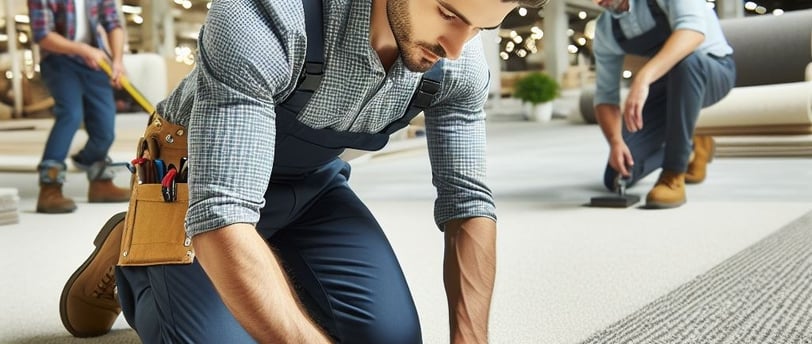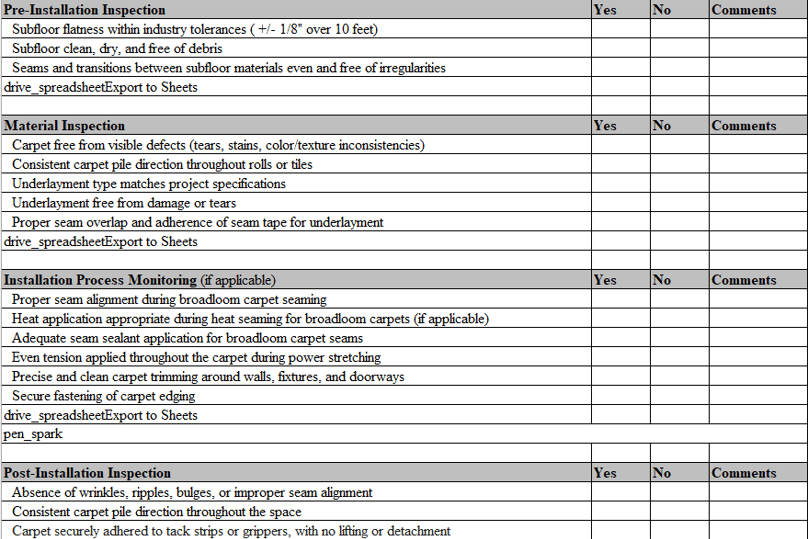Commercial flooring - Carpets
Installing carpets in commercial setting.
COMMERCIAL PROJECTS
10/31/20236 min read


The Art of Carpeting: A Detailed Guide to Commercial Carpet Installation
Carpeting is a popular choice for commercial spaces, offering comfort, sound absorption, and a variety of aesthetic options. However, a successful commercial carpet installation requires careful planning, precise execution, and the right tools and materials. This comprehensive guide delves into everything you need to know to navigate the world of commercial carpet installation.
Types of Commercial Carpets:
Broadloom Carpets: These wide rolls, typically 12 or 15 feet wide, are ideal for large open areas. They come in various fiber types:
Nylon: Durable, stain-resistant, and long-lasting, making it a popular choice for high-traffic areas.
Polypropylene: Affordable option with good moisture resistance, but less durable than nylon.
Wool: Luxurious and naturally stain-resistant, but more expensive and requires delicate cleaning.
Solution-dyed Polyester: Vibrant colors that resist fading, often used in schools or retail spaces.
Modular Carpets: These interlocking tiles, typically 18"x18" or 24"x24", offer easy maintenance and replacement. They come in similar fiber options as broadloom carpets.
Choosing the Right Underlayment:
The underlayment, a layer placed beneath the carpet, plays a crucial role in comfort, noise reduction, and carpet longevity. Common underlayment types include:
Rebond Pad: Made from recycled materials, offering good value for moderate-traffic areas.
Polyurethane (PU) Pad: Provides excellent comfort and noise reduction, ideal for high-traffic areas.
Crumb Rubber Pad: Durable and water-resistant, suitable for basements or moisture-prone areas.
Gripper Pad: Combines a foam core with gripper strips along the edges to hold the carpet taut and prevent bunching.
Installation Process:
Subfloor Preparation: Ensure the subfloor is clean, level, smooth, and free of moisture. Address any unevenness with patching compound or sanding. Prime the subfloor if necessary.
Underlayment Installation: Lay the underlayment loose, aligning seams and trimming edges where necessary. Use seam tape to secure adjoining underlayment pieces.
Carpet Rolling and Seaming: Broadloom carpets are typically rolled out in the farthest corner from the exit, ensuring the nap (pile direction) runs consistently throughout the space. Seams for broadloom carpets are joined using a seam sealant and heat seaming iron for a seamless appearance. Modular carpets are simply laid out in a predetermined pattern, snapping together with their interlocking edges.
Power Stretching: Using a power stretcher, the carpet is stretched taut and secured to the perimeter of the space using tack strips or carpet grippers. This prevents wrinkles, ripples, and future bubbling.
Trimming and Edging: Using a sharp utility knife and straightedge, meticulously trim the carpet around walls, fixtures, and doorways for a clean finish. Carpet edging (metal or plastic) is then secured along the perimeter to conceal raw edges and provide a finished look.
Time Estimation:
Commercial carpet installation time varies depending on factors like carpet size, complexity of the layout, and crew experience. A basic rectangular room might take a professional crew 2-4 hours per 1,000 square feet, while intricate layouts with cutouts or corners could extend the time.
Cutting Techniques:
Straight Cuts: Utilize a straightedge and utility knife for precise straight cuts.
Seams and Corners: For seams and complex shapes, use a carpet seaming iron to melt the carpet fibers and create a seamless joint.
Templates: For intricate cutouts around pillars or doorways, create paper templates to ensure accurate carpet shaping.
Essential Equipment:
Power Stretcher: Applies even tension throughout the carpet.
Seaming Iron: Creates strong, invisible seams for broadloom carpets.
Utility Knife and Straightedge: For precise carpet cutting.
Seam Tape: Secures underlayment seams for a smooth surface.
Tack Strips or Carpet Grippers: Secure the carpet perimeter and prevent bunching.
Knee Pads: Protect your knees during prolonged periods of kneeling.
Adhesives:
While carpeting is primarily secured through power stretching and tack strips, specific situations might require adhesives for additional stability:
Carpet Pad Tackifier: A spray adhesive applied to the subfloor to ensure a strong bond between the underlayment and the subfloor, particularly on uneven surfaces.
Seam Sealant: A liquid adhesive applied to the carpet backing during the seaming process to create a permanent, invisible bond.
Installation Methods:
Several commercial carpet installation methods cater to different project needs.
Estimating Carpet Installation Costs for a Commercial Project (1000 sq ft Example)
Accurately estimating the cost of commercial carpet installation is crucial for budgeting and project planning. Here's a breakdown of the key factors to consider when calculating the cost for a 1000 sq ft space:
Materials:
Carpet: Prices vary significantly based on fiber type, quality, and brand. A good starting point for commercial broadloom carpet could be $3 - $8 per square foot. (1000 sq ft * $5/sq ft = $5,000)
Underlayment: Underlayment cost depends on the chosen pad type. Rebond pads might be $0.50 - $1.00 per square foot, while PU pads can range from $1.00 - $2.00 per square foot. (1000 sq ft * $1.00/sq ft = $1,000) (Consider this a mid-range option)
Seam Tape: Typically sold by the roll and relatively inexpensive, budgeting $25 - $50 should suffice for a 1000 sq ft project.
Tack Strips/Gripper Rods: Sold by the linear foot, costing around $0.10 - $0.20 per foot. For a 1000 sq ft space (assuming a basic rectangular layout), the perimeter might be around 150 linear feet. (150 ft * $0.15/ft = $22.50)
Carpet Edging: Similar to tack strips, sold by the linear foot and priced around $0.10 - $0.20 per foot. (Refer to perimeter footage calculation above for edging cost estimation).
Labor:
Installation labor costs can vary depending on geographic location, crew experience, and project complexity. A ballpark figure for commercial carpet installation might be $1.50 - $3.00 per square foot. (1000 sq ft * $2.00/sq ft = $2,000)
Overhead Costs:
Factor in additional overhead costs that the installation company may incur, such as transportation of materials, equipment rental, and waste disposal. This could be around 10-15% of the total material and labor costs. (Material + Labor) * 0.15 = ~$450
Example Cost Breakdown (1000 sq ft):
Carpet: $5,000
Underlayment: $1,000
Seam Tape: $50
Tack Strips/Grippers: $22.50
Carpet Edging: $22.50 (Assuming same perimeter footage)
Labor: $2,000
Overhead: $450
Total Estimated Cost: $8,472.50
Important Considerations:
This is a sample cost breakdown, and actual prices may vary depending on your specific project details.
Obtain quotes from multiple reputable flooring contractors for the most accurate pricing for your project.
Factor in potential additional costs such as carpet removal and disposal of existing flooring (if applicable).
Always ask about warranties and guarantees offered by the installation company.
Ensuring a Flawless Finish: Quality Assurance and Control (QA/QC) in Carpet Installation
A successful commercial carpet installation goes beyond just laying down the material. Implementing a robust Quality Assurance and Quality Control (QA/QC) program is essential to ensure the finished product meets all specifications and delivers optimal performance. Here's what you need to know about establishing quality criteria for your commercial carpet project:
Pre-Installation Inspection:
Before any carpet is rolled out, conduct a thorough inspection of the subfloor. Key areas to examine include:
Flatness and Levelness: Uneven subfloors can lead to carpet imperfections like ripples and bumps. Ensure the subfloor is within industry tolerances (typically +/- 1/8" over 10 feet) using a straightedge and level.
Cleanliness and Debris: Dirt, debris, or moisture on the subfloor can compromise carpet adhesion and lead to future problems. The subfloor should be clean, dry, and free of contaminants.
Seams and Transitions: Inspect existing subfloor seams or transitions between different materials (concrete, tile) for any unevenness that might telegraph through the carpet. Address any inconsistencies with patching compound or sanding.
Material Inspection:
Carpet Appearance: Carefully examine the carpet for any visible defects like tears, stains, or inconsistencies in color or texture. Ensure the carpet pile direction (nap) is consistent throughout the rolls or tiles.
Underlayment Quality: Verify the underlayment type matches project specifications and is free of damage or tears. Check for proper seam overlap and adherence of seam tape.
Installation Process Monitoring:
Seaming Techniques: Observe the seaming process to ensure proper seam alignment, heat application during heat seaming, and adequate seam sealant application for broadloom carpets.
Power Stretching: Monitor the power stretching process to ensure even tension is applied throughout the carpet. Avoid excessive stretching that can damage the carpet backing.
Trimming and Edging: Verify that carpet trimming around walls, fixtures, and doorways is precise and clean. Ensure carpet edging is securely fastened and provides a finished look.
Post-Installation Inspection:
Visual Inspection: Perform a meticulous visual inspection of the entire carpeted area for any imperfections like wrinkles, ripples, bulges, or improper seam alignment.
Pile Direction: Confirm consistent carpet pile direction throughout the space.
Carpet Adhesion: Check for any areas where the carpet might be lifting or detaching from the tack strips or grippers.
Cleaning and Maintenance: Review proper cleaning and maintenance procedures with the building maintenance staff to ensure the longevity of the carpet installation.


